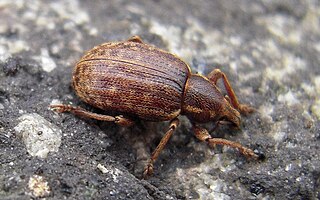
Zapus is a genus of North American jumping mouse. It is the only genus whose members have the dental formula 1.0.1.31.0.0.3. Zapus are the only extant mammals aside from the Aye-aye with a total of 18 teeth.
Rhyncogonus is a genus of beetle in the family Curculionidae. The genus is endemic to islands in the Pacific Ocean.

Scaphinotus is a genus of beetles in the family Carabidae. There are at least 60 species, all native to North America. They eat snails and are generally limited to the moist environments where snails live. These beetles are flightless.

Paraptochus oregonus is a species of weevils in the beetle family Curculionidae. It is found in Oregon and the Pacific Northwest.

Panscopus is a genus of broad-nosed weevils in the beetle family Curculionidae. There are more than 30 described species in Panscopus, found in North America.
Peritelinus is a genus of broad-nosed weevils in the family Curculionidae. There are at least 3 described species in Peritelinus.

Ophryastes is a genus of broad-nosed weevils in the family Curculionidae. There are at least 30 described species in Ophryastes.

Lepidophorus is a genus of broad-nosed weevils in the family Curculionidae. There are about 13 described species in Lepidophorus.
Crocidema is a genus of broad-nosed weevils in the beetle family Curculionidae. There are about six described species in Crocidema.
Sciopithes is a genus of broad-nosed weevils in the beetle family Curculionidae. There are about six described species in Sciopithes.
Eucyllus is a genus of broad-nosed weevils in the beetle family Curculionidae. There are about eight described species in Eucyllus.

Lepyrus is a genus of true weevils in the beetle family Curculionidae. There are more than 70 described species in Lepyrus.
Aragnomus is a genus of broad-nosed weevils in the beetle family Curculionidae. There are at least three described species in Aragnomus.
Adaleres is a genus of broad-nosed weevils in the beetle family Curculionidae. There are at least three described species in Adaleres.
Peritaxia is a genus of broad-nosed weevils in the beetle family Curculionidae. There are about seven described species in Peritaxia.
Omias is a genus of broad-nosed weevils in the beetle family Curculionidae. There are more than 50 described species in Omias.
Lepyrus oregonus is a species of true weevil in the beetle family Curculionidae. It is found in North America.
Miloderoides is a genus of broad-nosed weevils in the beetle family Curculionidae. There are at least three described species in Miloderoides.
Cryptolepidus is a genus of broad-nosed weevils in the beetle family Curculionidae. There are about eight described species in Cryptolepidus.

Romualdius is a genus of snout and bark beetles in the family Curculionidae. There are a dozen described species in Romualdius. The genus was raised by Roman Borovec in 2009 for a group of species formerly assigned to Trachyphloeus, and is named after the eminent Czech entomologist Romuald Formánek (1857-1927).








